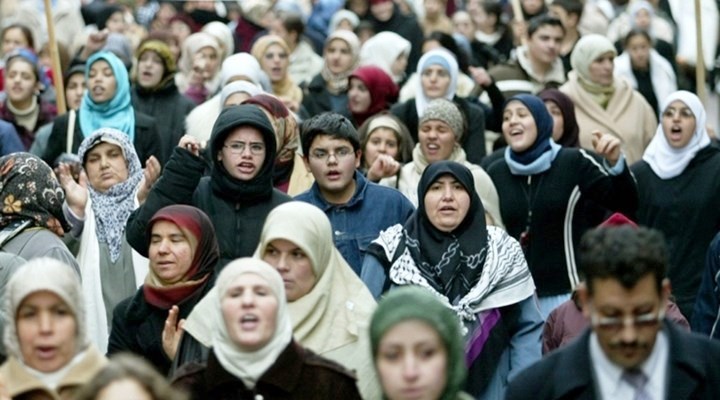
Germany
's top court said in a ruling that overturns an earlier ban. (Photo: world.bgnnews.com)" width="365" height="203" /> Muslim women teachers can wear headscarves as long as it does not cause disruption in school, Germany’s top court said in a ruling that overturns an earlier ban. (Photo: world.bgnnews.com)Berlin, 22 Jumadil Awwal 1436/14 March 2015 (MINA) – The Federal Constitutional Court ruled on Friday that female Muslim teachers may wear head scarves in school.
The 6-to-2 ruling from the court in Karlsruhe stipulated that teachers may wear the head scarf so long as it does not cause disruption in the school, according to The New York Times report quoted by Mi’raj Islamic News Agency (MINA), Saturday.
The decision comes amid growing tensions throughout Europe over the absorption of thousands of Syrian refugees and other Muslims, stoking nationalism in many parts of the continent.
Several politicians and legal experts welcomed the ruling as an advance for religious and individual freedom. Leaders of Germany’s estimated 3.5 million Muslims noted that Muslim women who had previously declined to train as teachers for fear they would not be able to wear the head scarf in school would now be encouraged to do so.
Also Read: Protesters in London Denounce Israeli Violations of Gaza Ceasefire
Although the ruling does not mean a general permission to wear the head scarf, “it is cause for joy,” said Nurhan Soykan, general secretary of the Central Council of Muslims in Germany. “It gives worth to Muslim women in Germany and lets them participate in social life as citizens with equal rights.”
Christian Pestalozza, a constitutional law professor at Berlin’s Free University, said, “I especially like that the court does not give either a blanket ruling that anything goes, or a blanket ban.”
But teachers and school principals could face a challenge. Some news media commentators also worried that the ruling would fan anti-immigrant sentiment and perhaps lend new support to Pegida, an anti-Islam protest movement that started in Dresden and argues that Europe is being “Islamized.”
“Pegida will celebrate,” the leftist Taz newspaper said on its front page.
Also Read: Russia Defends Indonesia, Calls IOC “Hypocritical” Over Israel Visa Dispute
Udo Beckmann, the chairman of one of Germany’s biggest teachers organizations, said the ruling puts a new burden on school principals to decide whether wearing the head scarf constitutes a real disruption. It also potentially increases pressure on Muslim girls from traditional families or social groups to wear the head scarf, Mr. Beckmann said.
“The head scarf ban in schools created a certain zone of protection for girls who were being pressed to wear the covering,” he said in a telephone interview. “This space will now disappear.”
Concerns about Muslims and their influence are common across Europe, which is now home to an estimated 18 million Muslims, out of a total population of about 500 million.
The ruling leaves Germany in stark contrast to France, where a law bans conspicuous religious symbols, including Islamic head scarves, in state schools.
Also Read: IOC Suspends Indonesia’s Bid to Host Olympic Events After Visa Refusal for Israeli Athletes
Religious freedoms should be respected
French Muslim advocates welcomed the ruling. Elsa Ray, spokeswoman for the Collective Against Islamophobia in France, said the German court’s decision showed that religious freedoms should be respected.
But she said she had little hope that French courts would follow the German example. “We are very far from this in France, where, if anything, there is a push to extend the head scarf ban,” she said. “There is hysteria about Islam at the moment in France and a deformation of the notion of secularism that limits freedom of religion and conscience. The German decision can raise the same issue here, but the judicial environment will not change.”
The Karlsruhe court ruled on complaints brought by two unidentified Muslim women working in schools in North Rhine-Westphalia, Germany’s most populous state. One, a social science teacher, had substituted a woolen cap and rollneck pullover for a head scarf when asked to remove the head covering. She had nonetheless received a disciplinary warning, and then sued.
Also Read: ICJ Rules Israel Must Facilitate Humanitarian Aid to Gaza Under Geneva Convention
The second plaintiff was a woman who taught Turkish in several schools and eventually was fired for refusing to remove her head scarf.
Professor Pestalozza said he interpreted Friday’s ruling as taking immediate effect.
In its lengthy ruling, the court explicitly said that the freedom of religion and belief granted by Germany’s constitution allowed women in state schools to conform with a dress code stipulated by religion. In addition, it noted, forbidding women to wear the head scarf effectively excludes them from teaching and thus violates the constitutional requirement not to discriminate against women.
An 11-page statement from the court summarizing the ruling also specified that state schools should promote religious tolerance, and that permitting the wearing of a Jewish kippa, a nun’s habit or symbols like a cross is part of that tolerance.
Also Read: Israeli Fans Riot in Tel Aviv After UK Ban
By contrast, the ban on crosses, crucifixes or other religious symbols on the walls of state schools stands, the court ruled. “A cross or crucifix on the wall is something different,” Professor Pestalozza said. “If you put it up on the wall, then that is not an individual act by a teacher. It is the school, and by extension in effect the state.” (T/R04/P3)
Mi’raj Islamic News Agency (MINA)
Also Read: UK Bans Israel Supporters from Maccabi Tel Aviv Match at Aston Villa

































 Mina Indonesia
Mina Indonesia Mina Arabic
Mina Arabic